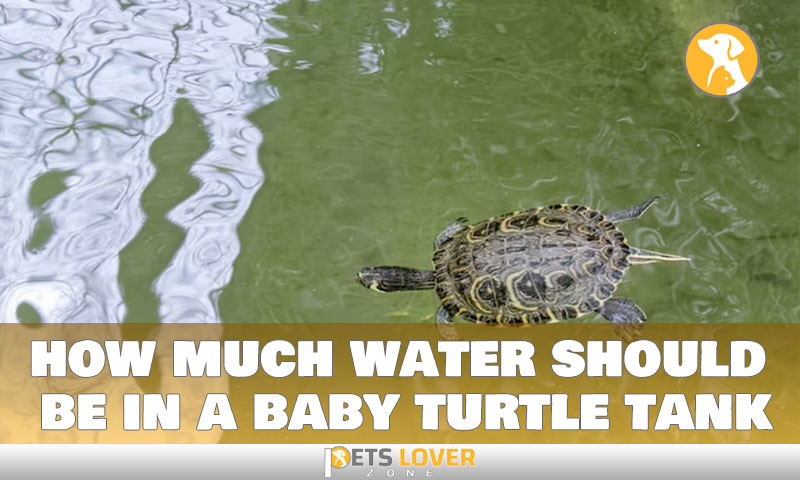The baby turtle tank should have enough water to submerge the turtle completely but not be too deep to prevent drowning. Baby turtles require a specific water level in their tank to ensure their safety and well-being.
It’s crucial to strike a balance between providing enough water for the turtle to swim and maintaining a shallow depth to prevent drowning. By adhering to this guideline, you can create a suitable habitat for your baby turtle that mimics its natural environment.
Providing the appropriate water level will not only satisfy the turtle’s physiological needs but also promote its overall development. In this article, we will explore the importance of correctly maintaining the water level in a baby turtle tank and provide helpful tips for achieving optimal water depth.
Importance Of Proper Water Levels

Providing The Ideal Habitat For Baby Turtles
When it comes to creating the perfect environment for your baby turtle, one of the most crucial aspects to consider is the water level in their tank. Maintaining the right water levels is vital for the health and well-being of your little reptile friend.
Proper water levels play a significant role in ensuring that your baby turtle thrives and grows in a suitable habitat that mimics its natural surroundings.
Ensuring their health and well-being:
- Baby turtles rely on water for various activities, such as swimming, hydration, and maintaining their body temperature. Adequate water levels ensure that they can engage in these activities without any difficulties.
- Maintaining proper water levels helps prevent stress and discomfort for baby turtles. Unnecessarily high or low water levels can cause unnecessary strain on their bodies, leading to health issues.
- The right water level also ensures efficient filtration and circulation, which helps maintain water quality and prevent the buildup of harmful bacteria or toxins.
Creating an environment that mimics their natural habitat:
- Baby turtles thrive when their tank environment resembles their natural habitat. This includes providing enough water depth to allow them to swim and explore.
- In nature, turtles live in bodies of water with varying depths. Providing different water levels in their tank allows them to engage in their natural behaviors and instincts, encouraging overall well-being.
- The right water level not only provides ample space for swimming but also facilitates basking. Turtles require areas with shallower water to rest and bask in heat, which is essential for their digestion and overall health.
By ensuring that your baby turtle has the correct water levels in their tank, you are creating an environment that promotes its health, happiness, and natural behaviors. Remember, providing the ideal habitat for your baby turtle involves more than just water levels.
Other factors such as temperature, lighting, and a suitable diet are also crucial. With careful attention to these factors, you can help your baby turtle thrive and enjoy a long and fulfilling life.
Factors To Consider When Determining Water Levels

Size And Species Of The Baby Turtle:
When determining the water levels for a baby turtle tank, it’s important to consider the size and species of the turtle. Different species have varying water requirements based on their natural habitats and behaviors. Here are some key points to take into account:
- Size: Baby turtles need adequate space to swim and move around comfortably. A small tank with insufficient water depth can restrict their movement and potentially hinder their development.
- Species: Different turtle species have different water preferences. Some may require deeper water, while others are more comfortable in shallower environments. Research the specific species of your baby turtle to understand its unique needs.
The Turtle’s Age And Growth Stage:
The age and growth stage of a baby turtle plays a crucial role in determining the appropriate water level in its tank. Consider the following points:
- Age: Younger baby turtles may be less skilled swimmers and may require shallower water levels initially. As they grow and develop their swimming abilities, the water depth can be increased gradually.
- Growth stage: Baby turtles experience rapid growth during their early stages. It’s essential to monitor their size and adjust the water level accordingly to ensure they have enough space to swim and explore comfortably.
Tank Size And Dimensions:
The size and dimensions of the tank housing the baby turtle are also important factors to consider when determining water levels. Here’s what you need to know:
- Tank size: The tank should be adequately sized to accommodate the turtle comfortably. A spacious tank allows for better water circulation, which is vital for the turtle’s health.
- Dimensions: The tank’s dimensions should also be considered when determining water levels. A longer tank provides more swimming space, while a wider tank allows for additional surface area, which can benefit certain turtle species.
Remember to regularly monitor your baby turtle and make adjustments to the water levels as it grows. Ensuring appropriate water depth based on the size, species, age, and growth stage of your baby turtle will contribute to its overall well-being and happiness in its tank environment.
Red-Eared Slider
Baby red-eared sliders are adorable little creatures that require specific care, especially when it comes to their tank setup. One crucial aspect to consider is the amount of water in their tank. Maintaining the right water depth is essential for the health and well-being of these aquatic turtles.
In this section, we will discuss the ideal water depth for baby red-eared sliders, the importance of a gradual slope or ramp, and creating a basking area above water level.
Ideal Water Depth For Baby Red-Eared Sliders:
- The water depth should be between 4 to 6 inches.
- This depth allows the baby turtles to swim and maneuver comfortably while still ensuring their safety.
- Too much water can make it difficult for them to reach the surface for breathing, and too little water may restrict their movement.
The Importance Of A Gradual Slope Or Ramp:
- It is crucial to provide a gradual slope or ramp from the water surface to the tank floor.
- Baby red-eared sliders may struggle to climb out of deep tanks without a proper incline, which can lead to stress and exhaustion.
- The slope or ramp should be made of non-slip materials to prevent accidents or injuries.
Creating A Basking Area Above Water Level:
- In addition to providing an appropriate water depth, it is essential to incorporate a basking area in the tank.
- This can be accomplished by elevating a platform or a group of rocks above the water.
- The basking area should be easily accessible for the baby turtles to climb onto and should provide enough space for them to rest and dry off completely.
- By having a basking area, the turtles can regulate their body temperature and receive the necessary UV rays for their overall health.
Remember, maintaining the ideal water depth, providing a gradual slope or ramp, and having a basking area are crucial elements in creating a suitable habitat for baby red-eared sliders. By following these guidelines, you can ensure the well-being and happiness of these adorable little turtles.
Painted Turtle
Baby-painted turtles require specific water conditions in their tank to ensure their health and well-being. The appropriate water depth and the provision of a shallow area for basking are crucial factors to consider. As the turtle grows, adjustments may need to be made to the tank setup to accommodate its changing needs.
Let’s explore these points further.
Appropriate Water Depth For Baby Painted Turtles
- Baby-painted turtles feel most comfortable in water that is not too deep. It is recommended to maintain a water depth of around 3 to 4 inches in their tank.
- This shallow water level allows the baby turtle to easily reach the surface for breathing without exerting too much effort.
- Having a shallow water depth also assists in regulating the temperature within the tank, ensuring that it remains suitable for the turtle’s overall development.
The Significance Of Providing A Shallow Area For Basking
- Just like adult turtles, baby-painted turtles also require a basking area where they can rest and warm themselves under a heat lamp or UV light.
- The basking area should be easily accessible from the water and have a shallow depth of around 1 to 2 inches. This allows the baby turtle to safely bask without the risk of drowning.
- Basking is important for digestion, thermoregulation, and the overall well-being of baby painted turtles. It helps them absorb essential nutrients and maintain their body temperature.
Possible Adjustments As The Turtle Grows
- As the baby-painted turtle grows, the water depth in the tank can be gradually increased to accommodate its increasing size and swimming abilities.
- It is recommended to increase the water depth by around 1 to 2 inches every month until the turtle reaches its adult size.
- While making adjustments, ensure that the basking area remains easily accessible and that the overall tank setup provides a balance between water and land for the turtle’s optimal health.
Remember, when it comes to setting up a tank for baby-painted turtles, providing an appropriate water depth and a shallow area for basking are essential. These aspects cater to their specific needs and ensure a healthy environment for their growth and development.
By making the necessary adjustments as the turtle grows, you can ensure it thrives in its tank.
Map Turtle
Baby map turtles are fascinating creatures that require a suitable environment to thrive and grow. One crucial aspect of setting up a baby turtle tank is determining the appropriate water depth for these little reptiles. The water depth plays a significant role in their ability to swim and engage in their natural behaviors.
Let’s delve into the specifics of providing the right water depth and ensuring sufficient space for baby map turtles to lead healthy and happy life.
Suitable Water Depth For Baby Map Turtles:
- Baby map turtles need a water depth that allows them to swim freely but also ensures their safety. Aim for a water depth of about 6 to 8 inches.
- This depth provides enough water for the turtles to swim around and explore, mimicking their natural habitat.
- It is important to avoid extremely shallow water, as it can limit their movements, and overly deep water can be dangerous for baby turtles, as they might have difficulty reaching the surface for air.
The Need For Swimming And Basking Areas:
- Along with a suitable water depth, baby map turtles also require a designated swimming area in their tank.
- Create a spacious and uncluttered swimming area where they can navigate with ease.
- Additionally, it is crucial to provide a basking area, such as a platform or rock, where the turtles can rest and dry off after swimming.
- The basking area should be easily accessible and positioned under a heat lamp or UV light to provide the necessary warmth and light for their overall development.
Ensuring Enough Space For Their Natural Behaviors:
- Baby map turtles are active and curious creatures, so it is essential to provide them with enough space to engage in their natural behaviors.
- Ensure that the tank size is appropriate for their needs, allowing them to swim, bask, and explore without feeling cramped.
- A larger tank size is generally better, as it allows for more natural movement and encourages healthier development.
- Remember to regularly clean and maintain the tank to promote a clean and hygienic environment for your baby map turtles.
By providing the right water depth, swimming and basking areas, and ample space, you can create an ideal habitat for baby map turtles to thrive. Remember to monitor their behavior and make adjustments as needed to ensure their overall well-being.
With proper care and attention to their environmental needs, these adorable reptiles will grow into magnificent map turtles.
Water Quality And Filtration Systems
Having clean and properly maintained water is crucial for the health and well-being of your baby turtle. As a responsible turtle owner, it’s essential to understand the importance of water quality and filtration systems. In this section, we will explore why maintaining clean water is vital, how to choose the right filtration system, and the importance of regular water testing and maintenance.
Importance Of Maintaining Clean Water
- Clean water is essential for the overall health and longevity of your baby turtle.
- It helps prevent the buildup of harmful bacteria and parasites that can cause diseases.
- Proper water quality ensures that your turtle’s respiratory system functions optimally.
- Clean water also helps to maintain healthy skin and shell conditions.
Choosing The Right Filtration System For A Baby Turtle Tank
- The filtration system plays a crucial role in maintaining water quality.
- A good filtration system removes waste, excess food, and toxins from the water.
- Look for a filter that provides mechanical, biological, and chemical filtration.
- Consider the size of your turtle tank when choosing an appropriate filtration system.
- Canister filters and power filters are popular options for turtle tanks.
Regular Water Testing And Maintenance
- Regular water testing is necessary to ensure that the water parameters are within the appropriate range.
- Test for ammonia, nitrite, nitrate levels, ph, and water hardness.
- Use test kits specifically designed for aquatic turtles.
- A regular water change schedule is essential to maintaining optimal water quality.
- Clean the filter regularly to prevent clogging and ensure its effectiveness.
Remember, turtles are highly sensitive to poor water conditions, and neglecting water quality can result in serious health issues. By understanding the importance of maintaining clean water, choosing the right filtration system, and performing regular water testing and maintenance, you can provide a healthy and thriving environment for your baby turtle.
Monitoring And Adjusting Water Levels
Having the right water level in a baby turtle tank is vital for the health and well-being of your little aquatic friend. As they grow, their water requirements will change, making it important to monitor and adjust the water levels accordingly.
In this section, we will explore the significance of regular monitoring and the process of adjusting water levels as your turtle gets bigger. We will also touch upon how to identify signs of stress or discomfort in your turtle, ensuring a safe and comfortable environment for them.
So, let’s dive in and discover the secrets to keeping your baby turtle’s tank perfectly balanced.
The Significance Of Regular Monitoring:
Regularly monitoring the water levels in your baby turtle tank is essential to maintaining a healthy and suitable environment for your pet. Here’s why:
- Water levels can affect the turtle’s ability to swim and navigate its tank, so keeping an eye on it helps ensure its comfort.
- Maintaining the correct water level is crucial for the efficiency of the filtration system, which keeps the water clean and prevents the buildup of harmful bacteria.
- Consistently monitoring the water levels allows you to identify any potential issues, such as leaks or water evaporation, and address them promptly.
Adjusting Water Levels As The Turtle Grows:
As your baby turtle grows, their water needs will change, requiring you to adjust the water levels accordingly. Here’s what you should consider:
- Baby turtles need shallower water to make it easier for them to reach the surface and breathe. Aim to provide water that is two to three times their shell’s height.
- Over time, as your turtle grows, gradually increase the water level. This will allow them to develop stronger swimming skills and explore their environment more freely.
- Keep in mind that different turtle species may have specific water level requirements, so research your turtle’s species to ensure you are providing optimal conditions.
Identifying Signs Of Stress Or Discomfort:
Just like any other pet, it’s crucial to know how to identify signs of stress or discomfort in your baby turtle. Pay attention to these indicators:
- Restlessness or excessive swimming near the tank edges might suggest that the water level is not suitable for your turtle’s needs.
- If you notice your turtle spending extended periods basking or struggling to reach the surface for air, it may indicate that the water level is too high.
- Unexplained aggression or unusual behavior can also be signs of stress caused by improper water levels.
- Regularly observe your turtle’s behavior and consult with a veterinarian if you notice any concerning signs or changes in their habits.
Monitoring and adjusting the water levels in your baby turtle tank is a crucial responsibility for any turtle owner. By keeping a close eye on the water levels, making necessary adjustments as your turtle grows, and being attentive to signs of stress or discomfort, you can ensure a conducive and healthy environment for your little shelled companion.
Remember, a happy turtle is a thriving turtle!
FAQs
How Much Water Should I Put In A Baby Turtle Tank?
A baby turtle tank should be filled with enough water for the turtle to swim and dive, but make sure it can still reach the surface to breathe easily.
What Is The Ideal Water Level For A Baby Turtle Tank?
The ideal water level for a baby turtle tank is usually around two to three times the length of the turtle’s shell.
Can I Fill The Tank With Tap Water?
Yes, you can fill the tank with tap water, but make sure to use a water conditioner to remove chlorine and other harmful chemicals.
How Often Should I Clean And Change The Water In A Baby Turtle Tank?
It is recommended to clean and change the water in a baby turtle tank at least once a week to maintain a clean and healthy environment for your turtle.
Conclusion
Maintaining the right water level in a baby turtle tank is vital for their overall health and well-being. Ensuring that the water is at the appropriate depth, typically around two-thirds to three-quarters of the tank’s height, allows the turtles to swim and exercise freely while also providing them with a sense of security.
It is essential to keep an eye on the water level, as baby turtles can easily drown in deep water due to their small size and limited swimming abilities. Additionally, ensuring the water is clean and free from any harmful chemicals or contaminants is crucial.
Regular monitoring and proper maintenance of the tank will not only contribute to the turtles’ growth but also minimize the risk of waterborne diseases. Remember, providing a suitable aquatic environment is essential for the healthy development of baby turtles.





